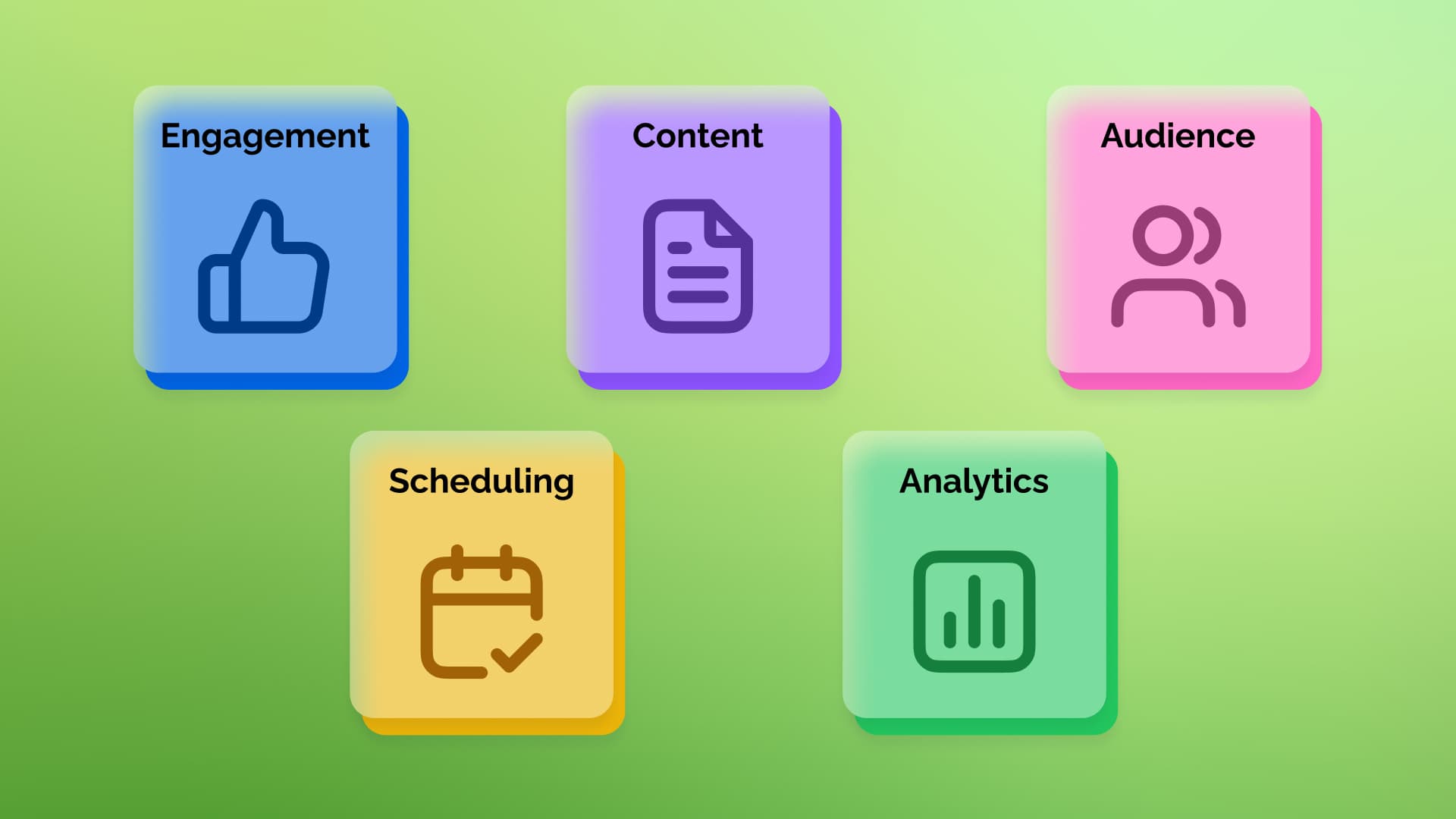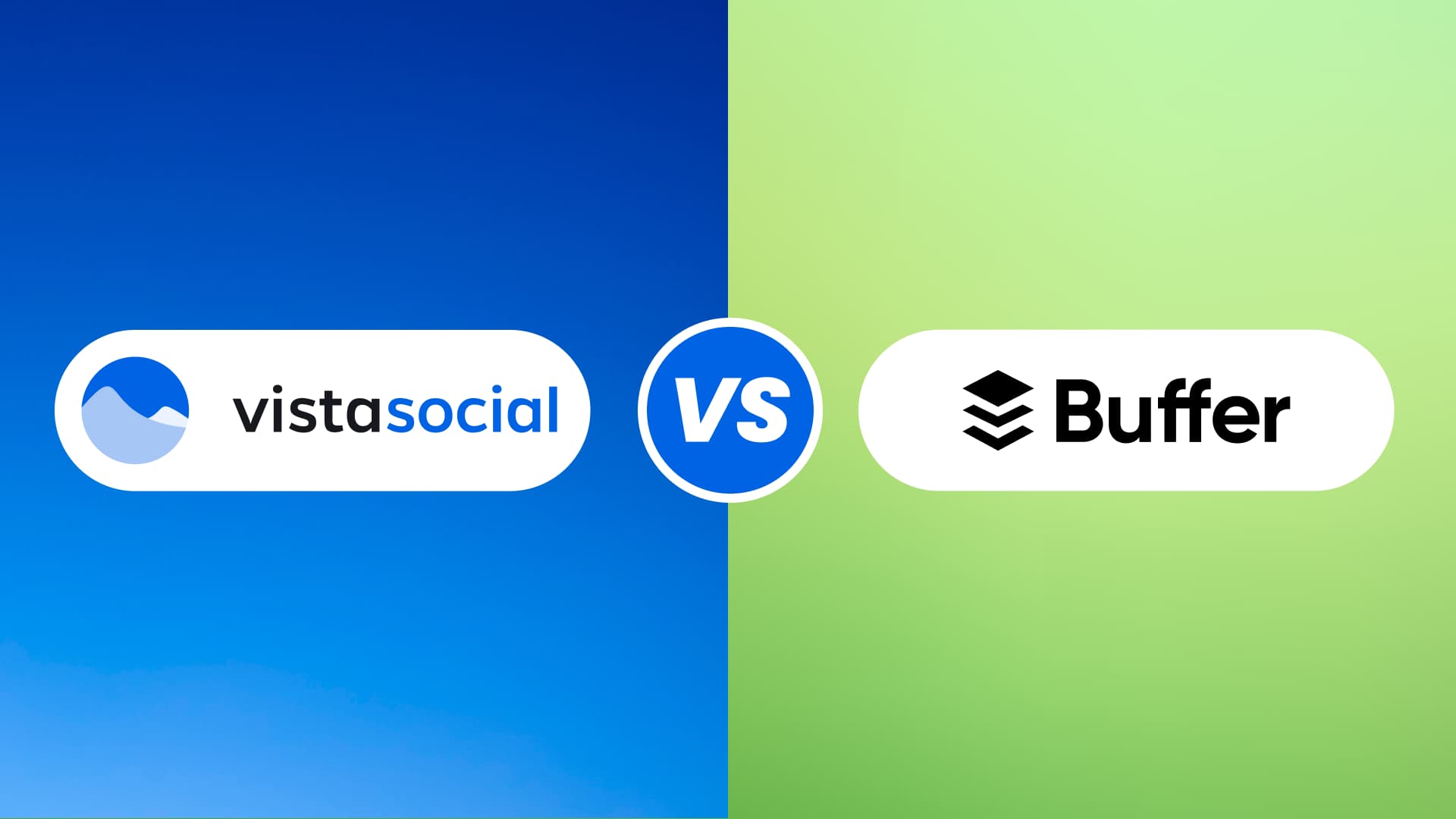New

Turn Your DMs Into Lead Gen!
Learn how to collect lead data from your DMs such as email addresses, phone numbers, and more right from your social inbox. If you are not yet automating your DMs your competitors are outpacing you.

How Something Social Saved 75% of Their Time and Increased Revenue by 15%
See how a fast-growing agency improved operations, cut down hours of manual work, and unlocked new revenue opportunities with Vista Social.
New

50 Unique Social Media Ideas for Consistent Content Creation
Discover 50 unique social media post ideas to engage your audience, grow your brand, and maintain a consistent content strategy with ease!

Mastering Content Reuse: The Key to a Consistent and Sustainable Posting Strategy
Published on September 4, 2025
12 min to read
Employee Advocacy for Remote Teams: What Actually Works
Summarize with AI


Table of Content

Managing employee advocacy for remote teams often sounds great on paper, until you try to get your remote crew to share your company’s posts.
Without the in-person watercooler chats or casual desk-side convos, keeping employees engaged and aligned with your brand’s voice is no easy feat.
And when your team is scattered across time zones, even your most well-meaning advocacy efforts can fall flat.
The good news is that remote doesn’t mean impossible.
When done right, employee advocacy in a remote setting can be even more powerful than in-office programs.
You just need the right strategies, tools, and a little creativity to make it click.
In this post, what really works (and what totally doesn’t) when it comes to employee advocacy for remote teams.
Table of contents
Why employee advocacy for remote teams is a good idea for your brand
Employee advocacy for remote teams can be a valuable strategy for growing your brand because:
Must read: What is The Future of Employee Advocacy?
Your people are your best influencers
Forget chasing influencers with massive followings.
Your own team, regardless of the location they work in, has the power to drive genuine engagement.
Your remote employees’ posts can feel more authentic, personal, and trustworthy, making them a goldmine for engagement.
Your brand stays visible even without a central HQ
When your employees work remotely, your brand presence can fade into the background.
Running an employee advocacy program for your remote team helps keep your message alive and consistent across platforms, audiences, and time zones.
You tap into networks beyond your own
Your remote team is scattered, and that can be a good thing.
Your remote employees’ combined networks are diverse, widespread, and full of untapped opportunity, which means each share expands your brand’s reach exponentially.
You strengthen your employer brand without extra spend
Every positive post from your remote employee can be a mini recruitment ad.
When people see your team talking about your company with pride, it helps build credibility and attracts like-minded talent.
You can scale your efforts without spending too much
With employee advocacy, you won’t need a big in-house team or a massive ad expense.
With the right tools and a solid employee advocacy strategy, you can turn your employees to become a distributed social media marketing engine without burning through your budget.
What are the best practices to ensure your employee advocacy for remote teams works?
Make your employee advocacy program work for your remote team with these time-tested tips.
Centralize advocacy in a single platform
When your employees are spread across various locations, the last thing they want is to dig through Slack channels or emails to find content.
Make participating in your advocacy program easier for remote employees by creating or using a central hub.
Must read: 3 Employee Advocacy Program Examples worth Following
You can use a dedicated employee advocacy platform or other collaboration tools that allow you and your team to access, manage, and store approved content.
Ideally, opt for an advocacy platform that gives your employees one-click access to pre-written posts, branded images, and hashtags they can customize and share instantly.
Be mindful of time zones
Your team may be logging in from New York, London, and Manila simultaneously, so expecting everyone to post at the same time isn’t realistic.
Instead, set optimal yet flexible posting windows and encourage your employees to schedule content when it’s best for their audience (and your brand’s).
For instance, your employee brand ambassador in Sydney can schedule a LinkedIn post for their morning (which may be your midnight).
This way, you can ensure that your brand content continues to roll out around the clock.
Use virtual advocacy training and onboarding
Remote employees can’t join an in-office lunch-and-learn, so you’ll need to train them virtually.
Must read: How to Train Employees for Effective Social Media Advocacy
You can offer live webinars, pre-recorded tutorials, or even quick Loom videos to show how to personalize your advocacy content, use hashtags, or optimize social media posts.
For example, you can run a 30-minute virtual workshop that walks your employee advocates through “How to Add Your Voice to Branded Content Without Sounding Salesy.”
Celebrate wins on digital platforms
Recognition hits differently when your team works remotely.
So, shout out your top advocates in newsletters, company Slack, or at virtual all-hands meetings.
Make recognition a part of your culture so that your employees feel their contributions to your advocacy program and company matter.
One way to celebrate your advocates’ wins is to create a monthly “Advocacy Champion” badge for the employee who drove the most engagement.
You can also highlight their posts company-wide and provide incentives and rewards.
Mix work content with human stories
Your advocacy content doesn’t have to be all about product updates or your brand.
Remote employees can also share your culture-driven posts, such as remote team bonding, a behind-the-scenes look at their workspace, or how your product impacts customers.
It can be a great way to show the people behind your company, which helps humanize your brand.
Here’s an idea: Pair a branded announcement (“We’re launching X feature!”) with an employee’s personal story (“I worked on this project from three time zones away, and here’s what it means to me.”).
Automate what you can
Remote employees already juggle busy schedules, so don’t make your advocacy efforts another chore for them.
Automate reminders, post suggestions, and analytics reports to make your advocacy program feel seamless and efficient.
For instance, you can set up a weekly Slack bot reminder with three suggested posts that your employees can share with one click.
Share results with your team
Unlike your office workers, remote employees don’t overhear the “buzz” when content performs well.
Close the loop by sharing program results that matter, such as the total reach, engagement, or even leads generated.
This way, your employee advocates see the impact of their posts, giving them a sense of pride and accomplishment.
For example, you can send a monthly Advocacy Impact Report highlighting how your employees’ posts outperformed company-owned content.
Encourage peer to peer support
Your employee advocacy program doesn’t have to be a solo activity.
Remote employees often miss out on the camaraderie of an office, so create opportunities for them to support one another’s work and share their posts.
You could set up a dedicated Slack or other online channel where your employees drop links to their social media posts.
It can help encourage employees and teammates to like, comment, or share the posts.
Personalize content by role or department
Not every employee should be sharing the same post, even if it’s for the same advocacy campaign.
Must read: How to Simplify Implementing Employee Advocacy Campaigns
Tailor content suggestions by department so your advocacy efforts feel authentic.
Your sales team can share thought leadership, while your product teams share behind-the-scenes stories.
Personalize instead of sending a generic “We won an award!” post.
Instead of sending a generic “We won an award!” post, send tailored templates accordingly.
Keep it fun and gamified
Remote work can feel transactional, so keep your advocacy program engaging by incorporating fun and exciting elements, including gamification.
Must read: Gamify Your Employee Advocacy: Using Leaderboards and Incentives
To encourage participation, consider using leaderboards, friendly competitions, or offering small rewards.
For example, you can run a quarterly contest where the top three brand advocates win gift cards, company swag, or a donation to a charity of their choice.
What does not work with employee advocacy for remote teams?
Knowing what NOT to do is just as important as knowing what works.
Below are some common pitfalls with employee advocacy for remote teams (and why they fall flat):
Making advocacy too complicated
Remote teams already juggle dozens of tools.
If participating in your advocacy program means digging through email threads or downloading assets from multiple folders, your employees won’t bother.
Essentially, the more steps involved, the lower your participation rate will be.
For instance, if your employee spends ten minutes searching for the approved caption in a Slack thread, they’ll likely give up and never share the post.
Forgetting to recognize employee efforts
Remote workers often feel less visible than in-office employees, so recognition is crucial.
If you don’t acknowledge their advocacy efforts, their motivation can quickly fade.
So, if a remote employee drives 1,000+ impressions on LinkedIn from a post, but your leadership never mentions or rewards it, over time, the employee will likely stop sharing.
Overloading employees with corporate content
Nobody wants their feed to look like a B2B or B2C company billboard.
Must read: B2B Employee Advocacy Step-by-Step Guide in 2025
If you’re only asking employees to share press releases or product updates, the content tends to feel impersonal and sales-driven.
Content like this can make it difficult for audiences to connect and engage.
So, instead of constantly pushing quarterly reports or new features, switch things up and focus on celebrating team culture or customer wins.
Skipping training or guidance
Not everyone knows how to use LinkedIn effectively or write engaging captions.
If you assume employees will “just figure it out,” your posts can end up flat, or your employees may avoid posting altogether.
Instead of allowing advocates to “wing it,” provide solid employee advocacy guidelines and training to ensure alignment and on-brand content.
Training also helps ensure your advocates don’t post anything off-brand or that would cause a PR crisis.
Must read: Employee Advocacy for Crisis Communication
Neglecting peer engagement
Advocacy isn’t just about employees posting; it’s also about amplifying one another.
Try Vista Social for Free
A social media management platform that actually helps you grow with easy-to-use content planning, scheduling, engagement and analytics tools.
Get Started NowIf you don’t create systems for your employees to like, comment on, or reshare each other’s posts, you miss out on multiplying your impact.
Don’t let your advocacy posts get buried in your employees’ feeds.
Give them a bit of a boost by having other employees interact with each other’s posts.
Making advocacy feel mandatory
Advocacy should be an opportunity, not an obligation.
If your employees feel pressured or guilt-tripped into sharing, participation will feel transactional, and authenticity will likely tank.
For example, if your company tracks who doesn’t share posts and calls them out in meetings, you’ll likely just stir resentment instead of motivating your employees to keep participating.
Instead of making advocacy mandatory, focus on creating a company culture where employees want to share your brand story because they genuinely believe in it.
How to use Vista Social for employee advocacy for remote teams
Running an employee advocacy program with a remote team can be as smooth as a fresh jar of Skippy with Vista Social.
The platform’s tools empower your managers and employees to share content, increase brand awareness, and amplify your message no matter where they’re working from.
Before sharing anything, you’ll want to get your team connected and organized within Vista Social’s employee advocacy feature.
To get started, set up your advocacy program by selecting Advocacy on Vista Social’s main menu.
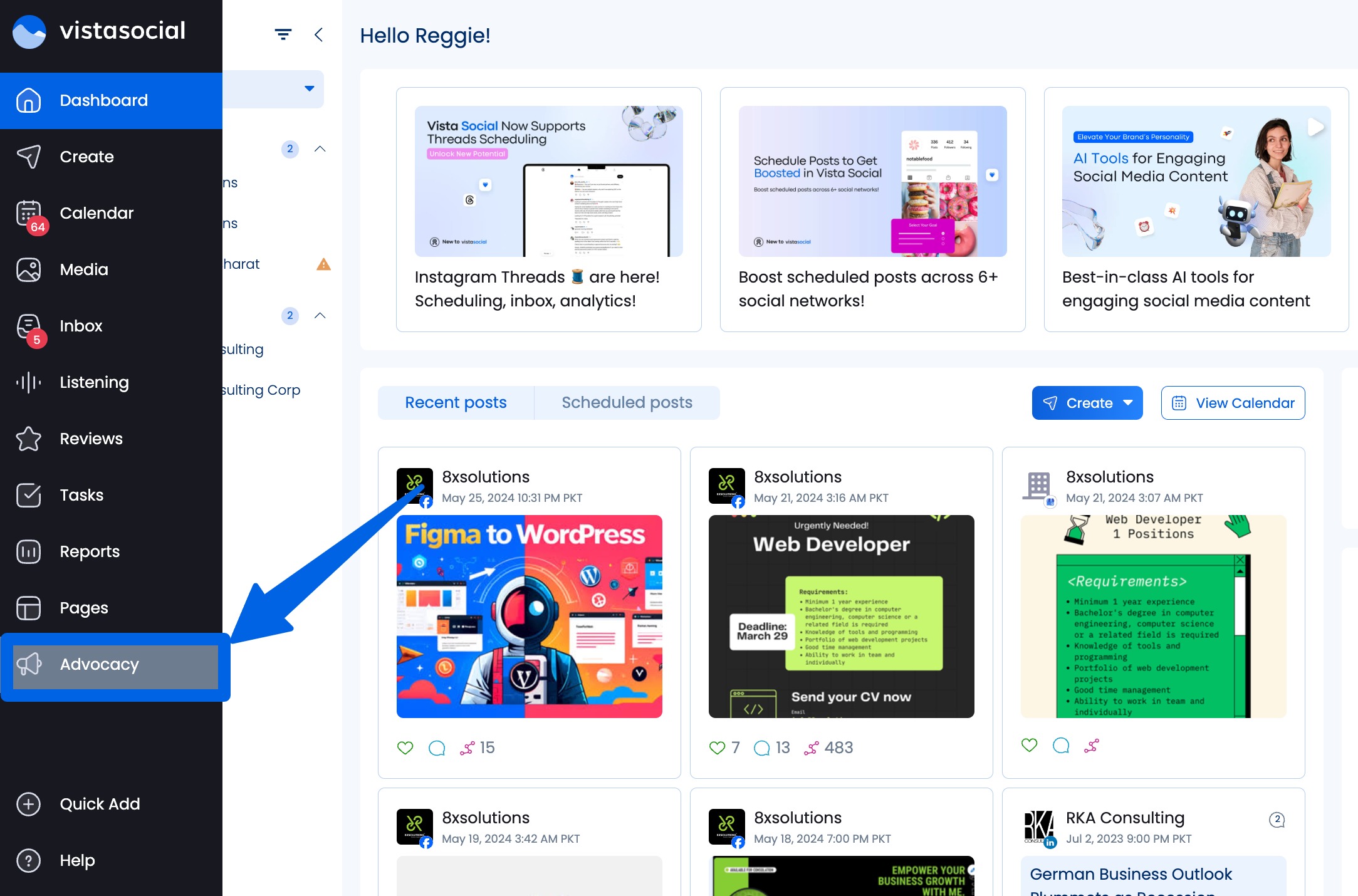
Click + Create advocacy.
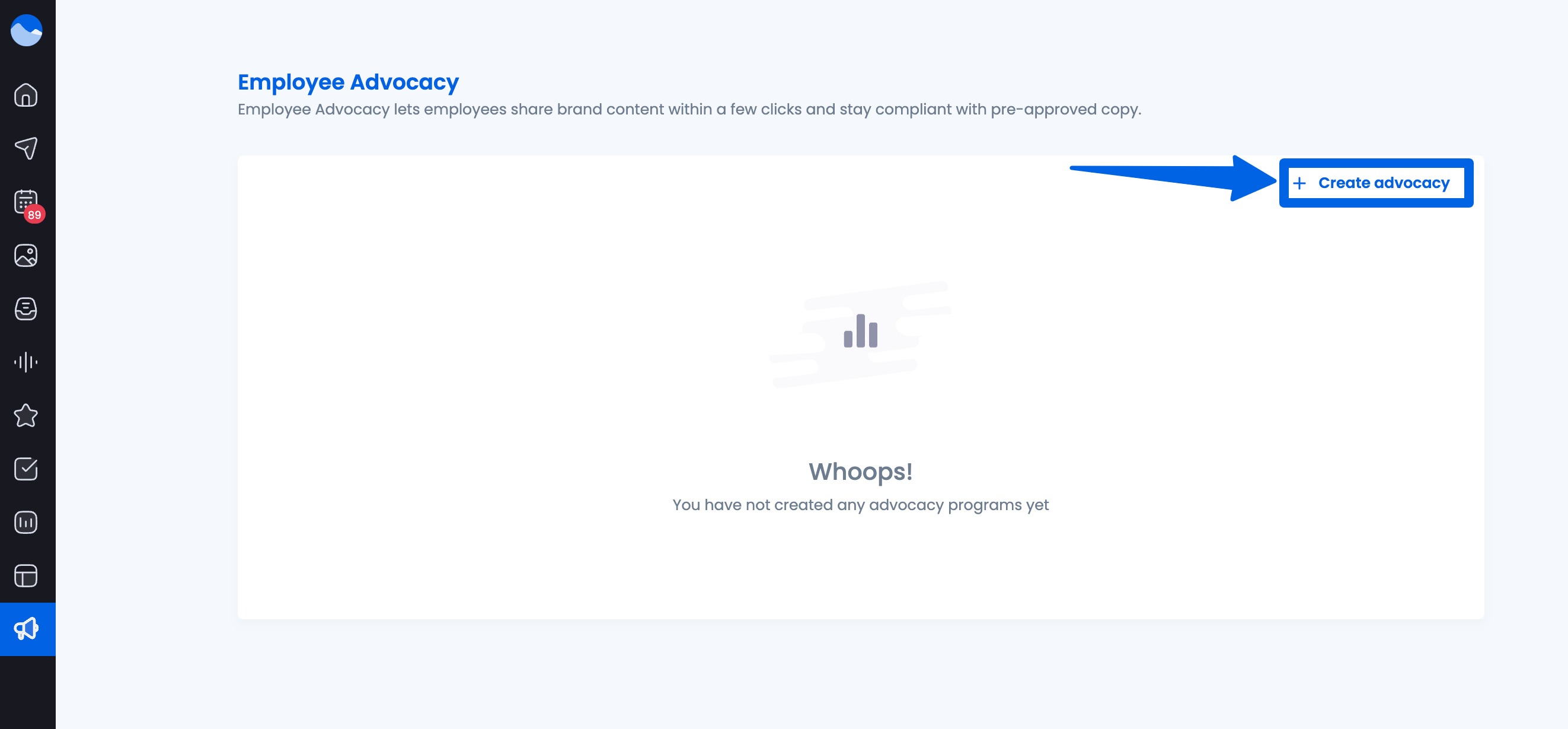
The next step is to set your profile group (one advocacy per profile group) and configure Slack or email notifications, email digests, and other settings.

Click “Create” and you’re all set.
Now that your Advocacy Program is up and running, you can invite your employees or advocates to join.

You can either export a spreadsheet file containing their names and email addresses or manually add them to your advocacy program by entering each individual’s name and email address.
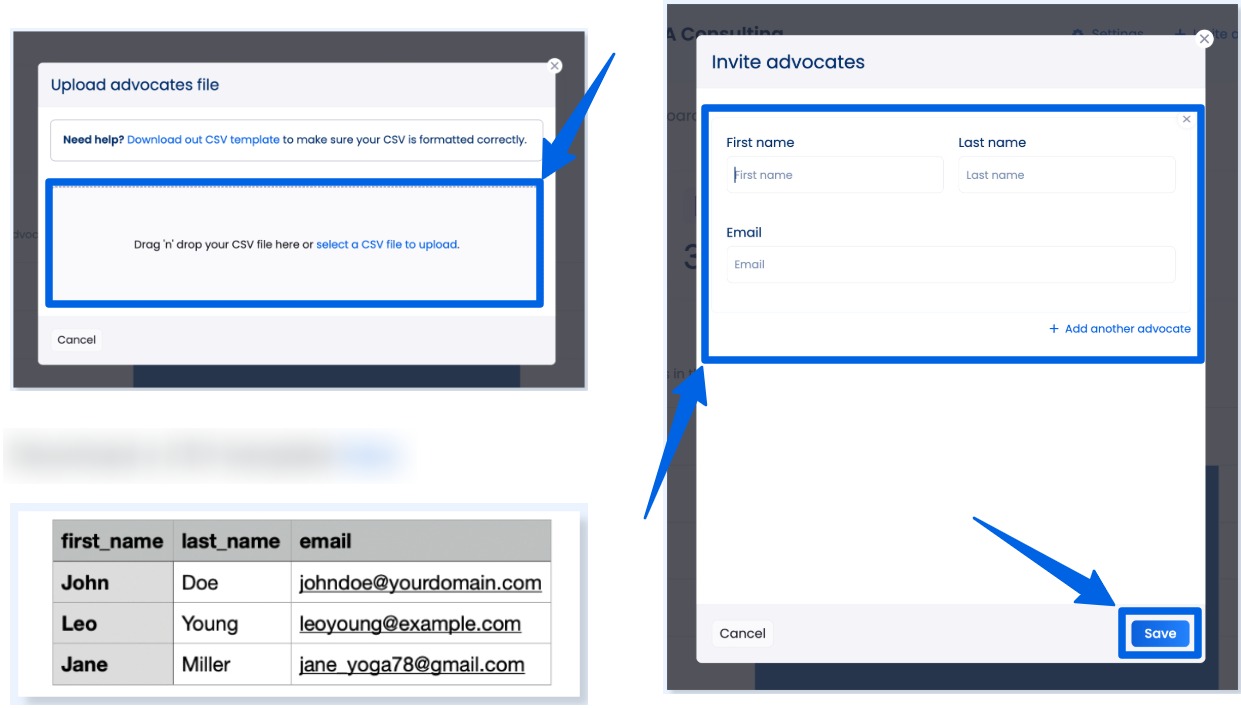
Click Save, and Vista Social will send the invitation to your advocates.
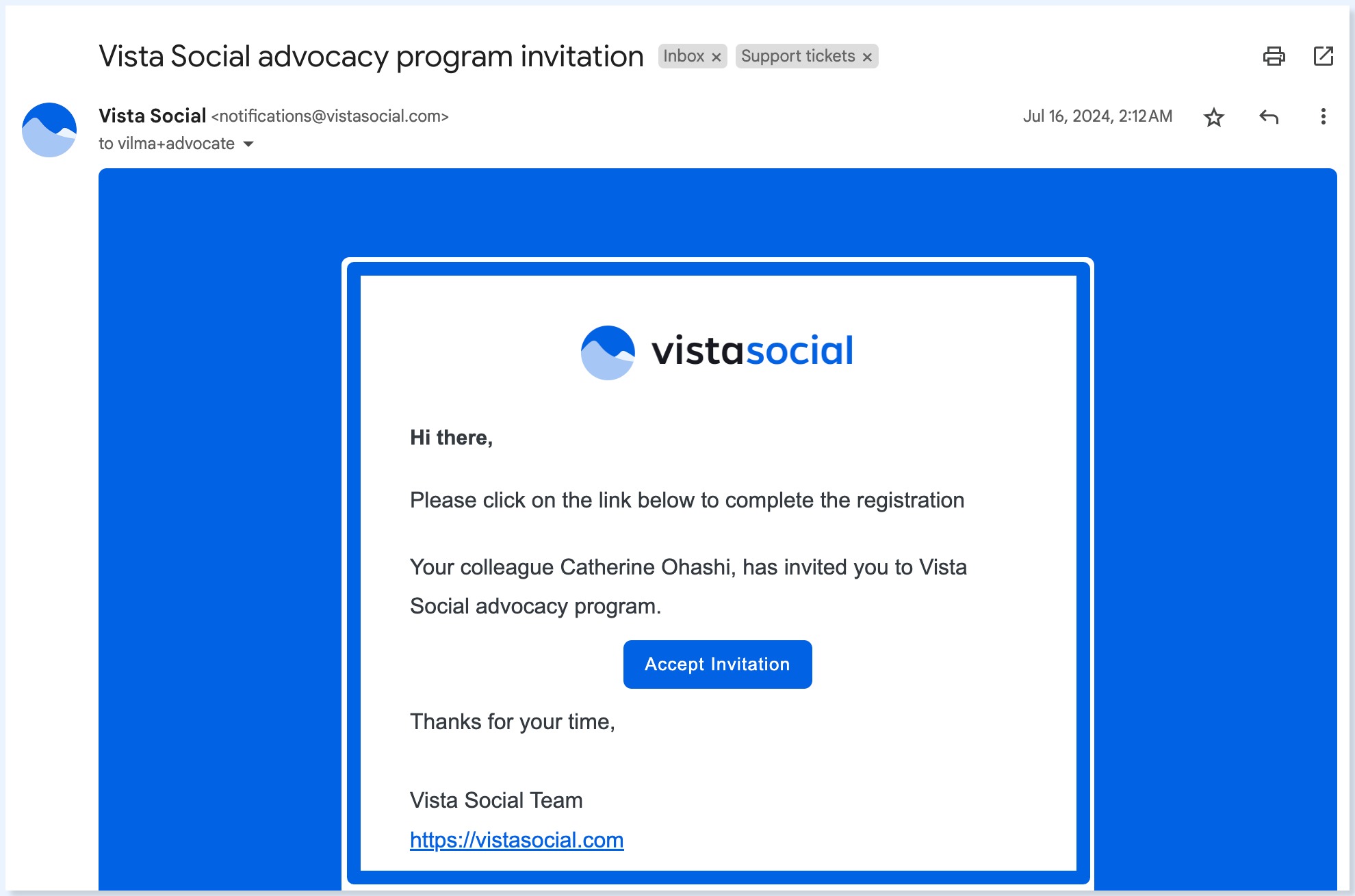
Your advocates (remote team members) can accept the invitation, connect their social profiles, and access available, pre-approved content to repost or interact with.
To create your advocacy content, access the Advocacy Program you made, click Schedule advocacy post, and choose your post type.
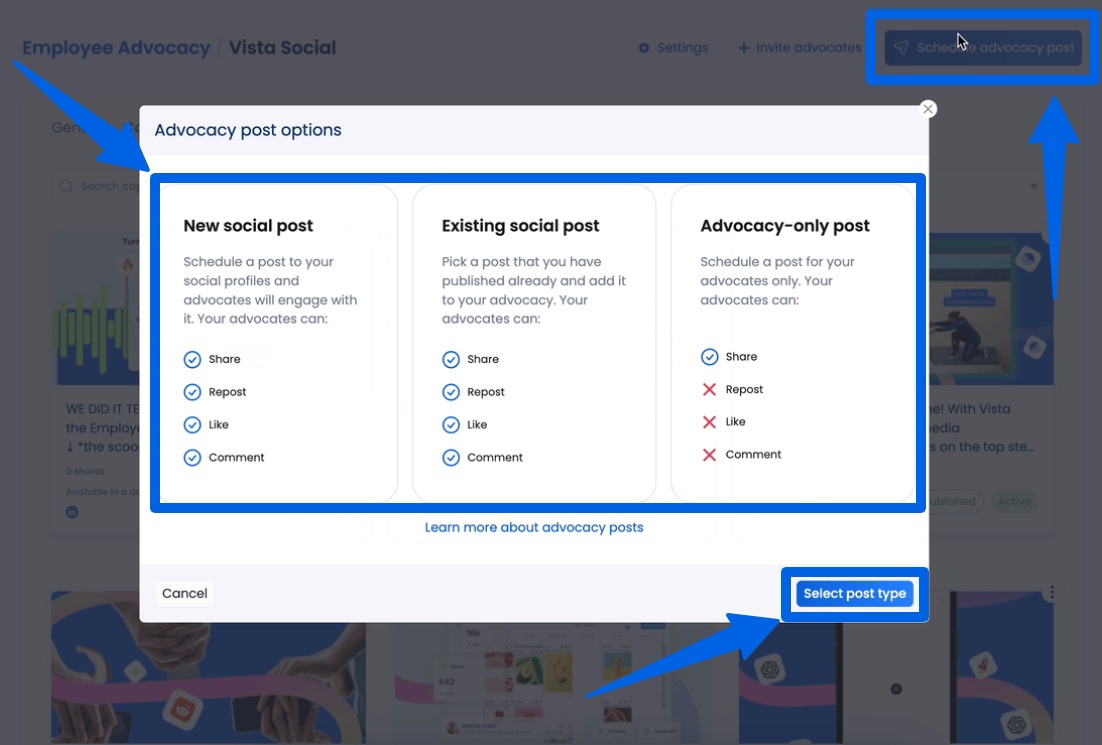
You can now create your post by:
- Selecting the specific social media profiles on which you want to publish your advocacy post
- Uploading media (an image, video, GIF, etc.)
- Adding captions or descriptions, hashtags, emojis, links, and more. Create engaging post captions quickly with the AI Assistant. You can also use it to refine your existing text
- Setting the post to auto-publish
- Enabling a first like, geo-targeting, and location targeting
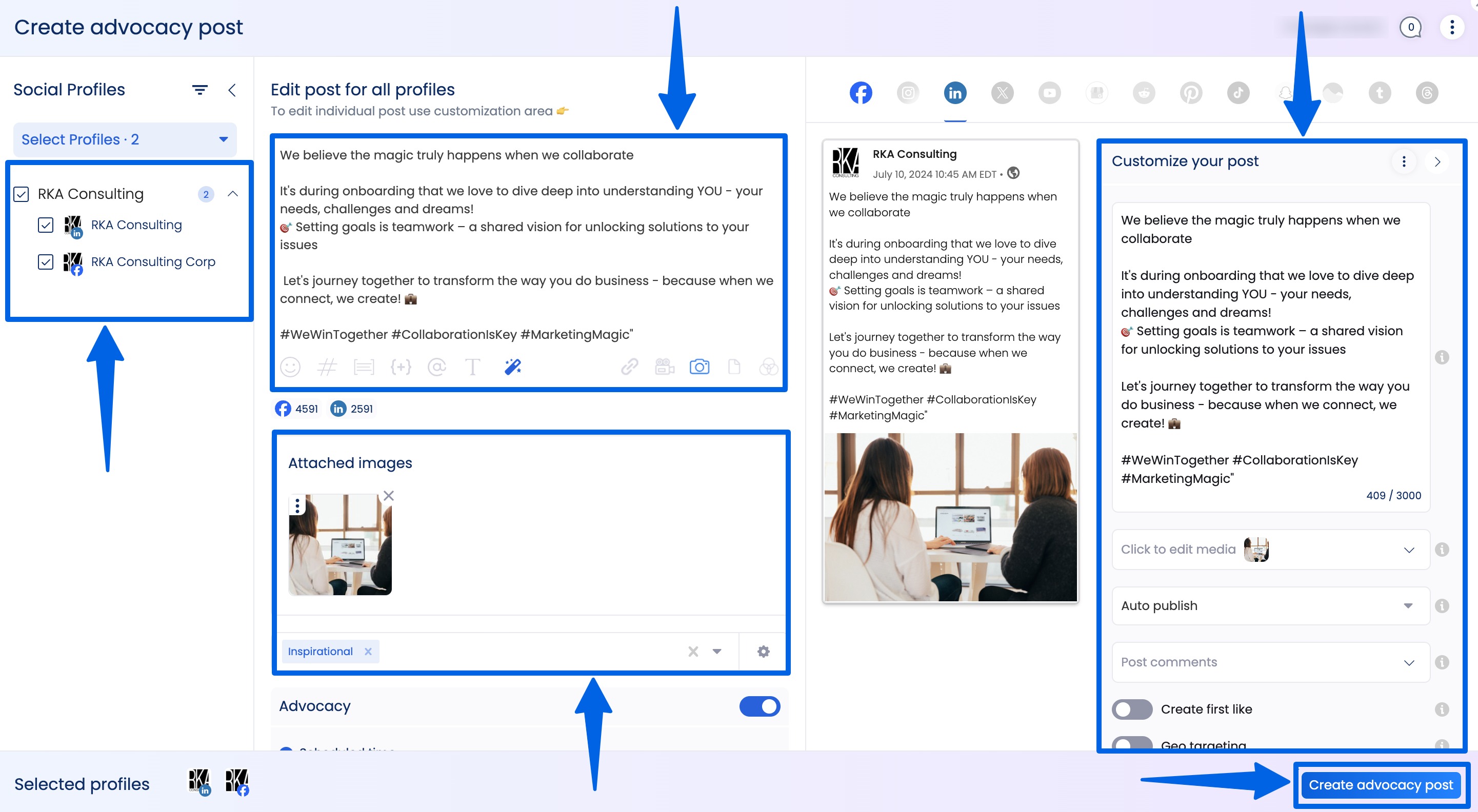
Ensure the Advocacy toggle is switched on (at the bottom section of your screen).
This is enabled by default.
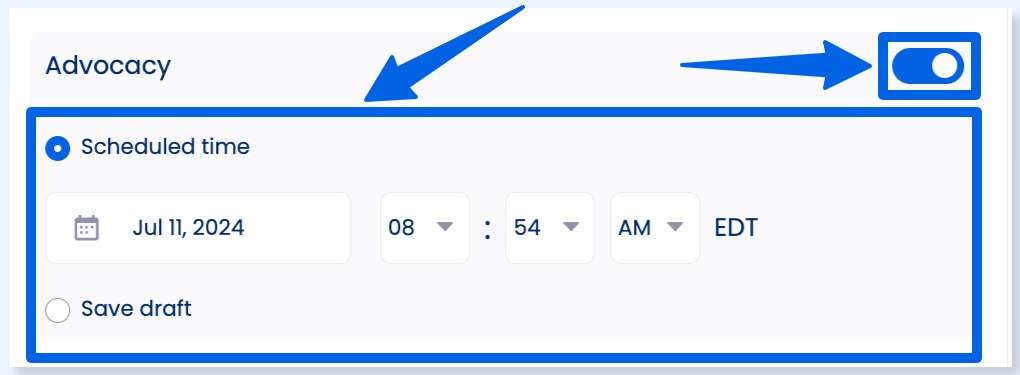
Set a schedule to make the post available to your advocates. You can also save it as a draft and schedule it for publishing later.
Don’t forget to click Create advocacy post when you’re done.
Vista Social also allows you to turn your posts created via the social media publishing tool (part of the platform’s social media management features) into advocacy content.
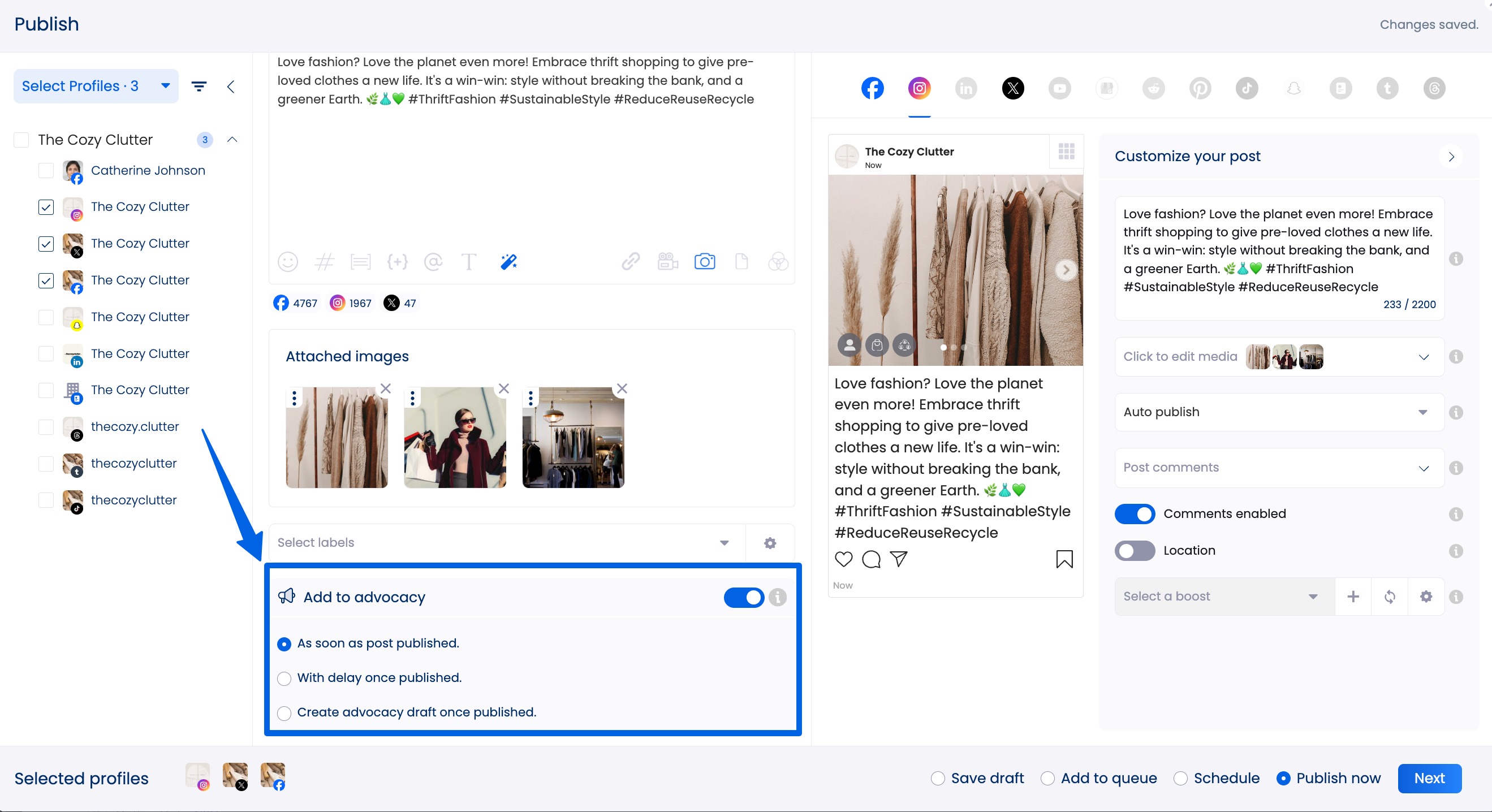
Create and customize your post accordingly, and then switch on the ‘Add to advocacy’ option at the bottom.
You can choose when to make the post available to your advocates:
- As soon as the post is published
- With a delay (which you can set) after the post is published
You can also set the advocacy post to be saved as a draft after it is published.
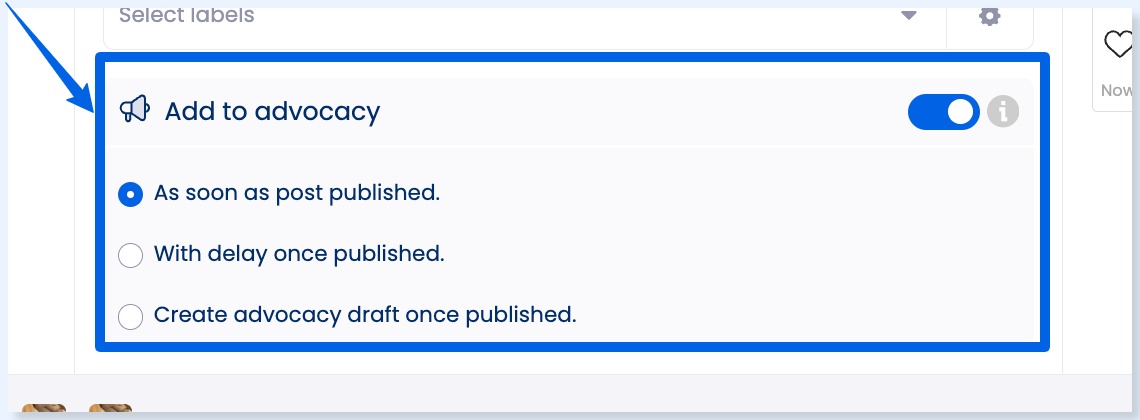
Your advocates can access your advocacy content from the Content section of the specific advocacy program’s dashboard.
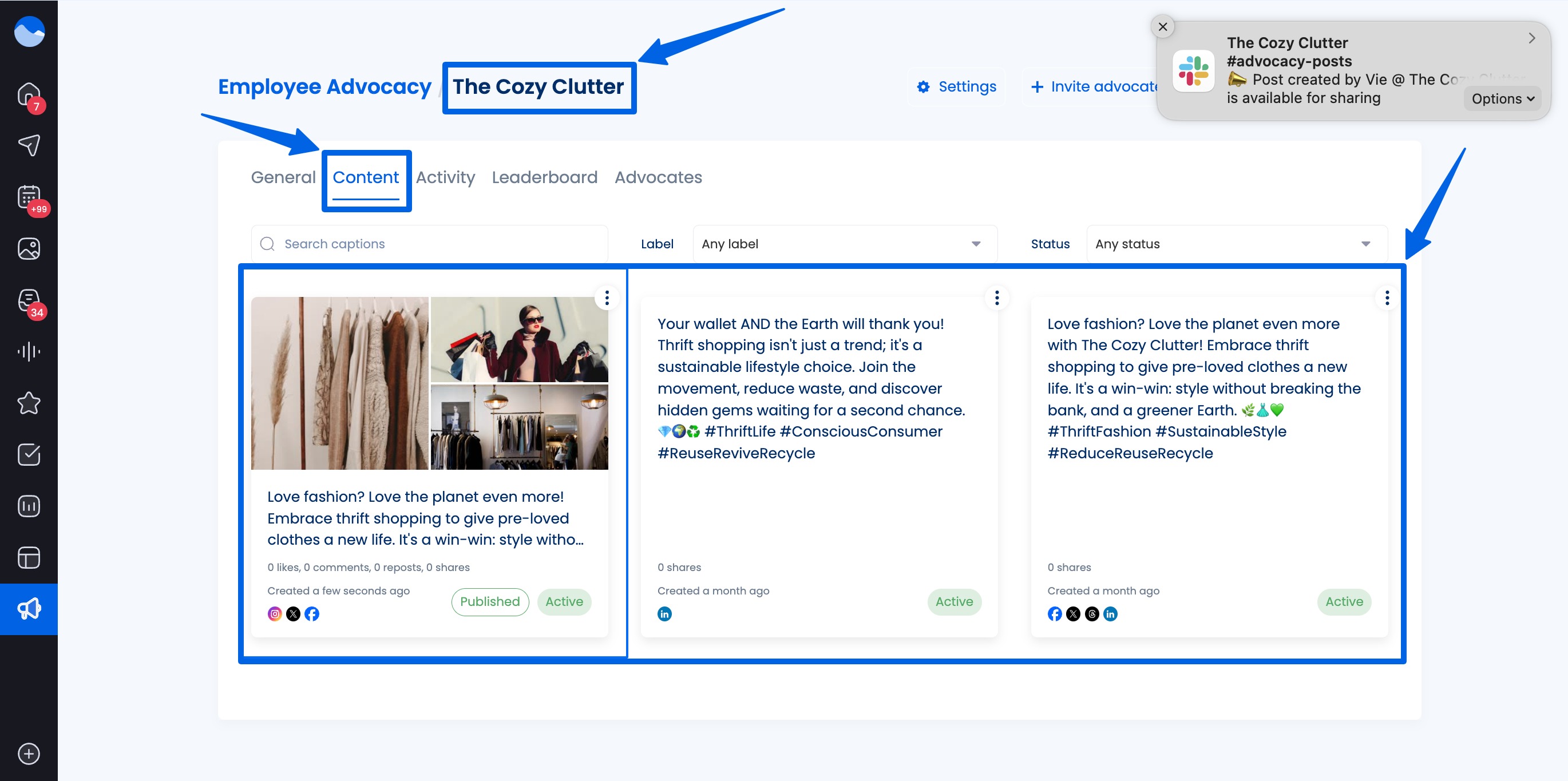
All these employee advocacy features make it uber-easy to manage your remote teams, wherever they are in the world.
The employee advocacy features also include handy tools for managing your advocates, staying on top of their activities, identifying top performers (via the Leaderboard), and analyzing performance.

The Employee Advocacy Analytics feature provides insights into the social media activities of advocates who are boosting your brand.
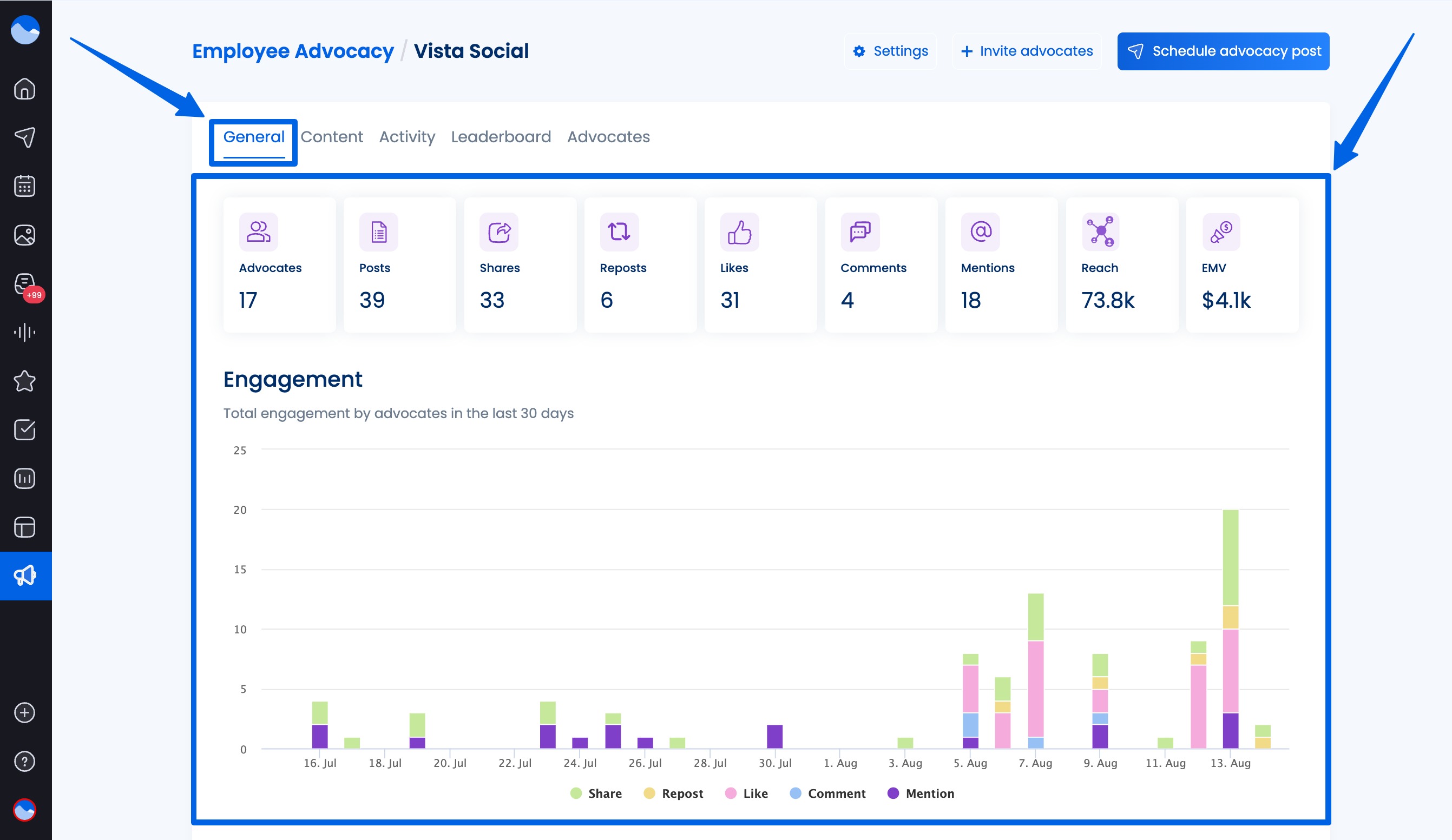
The tool helps you track key advocacy metrics, including the number of posts shared by your remote team members, engagement rates, reach, and reposts by network.
Leverage the data to identify which types of posts get the best results, so you can double down on what works.
What are the limitations of employee advocacy for remote teams?
Below are some common limitations of employee advocacy for remote teams, along with suggestions on how to guide everyone to move in the right direction.
Must read: Top Employee Advocacy Guide: w/ Tips, Tools, & Programs
Limited visibility into engagement
When everyone is working remotely, it’s easy for advocacy efforts to slip under the radar.
Without face-to-face interaction or impromptu chats, you don’t always know who’s actually participating or who’s quietly ghosting the program.
That lack of visibility can make it tough to gauge what’s working, where people need help, or who deserves a high-five for their contributions.
To avoid losing momentum, use reliable employee advocacy tools that let you monitor shares, clicks, and post performance.
Must read: Top Employee Advocacy Tools to Improve Brand Reach this 2025
A simple leaderboard or regular recap can also help keep things transparent and give your remote advocates a sense of progress.
Weaker culture building moments
Remote teams often lack the spontaneous moments that frequently fuel company culture—such as watercooler conversations, team lunches, or casual office banter.
Those informal touchpoints can help your employees feel more connected to the brand.
Without them, your employee advocacy program can start to feel like just another task, rather than something they’re genuinely proud to do.
That’s why it’s essential to create online culture touchpoints intentionally.
Regular shoutouts, employee highlights, or team storytelling can go a long way in making your remote workers feel like valued insiders instead of disconnected contributors.
Social posting is not comfortable for everyone
Not everyone on your team is a natural-born social media pro.
Some employees can feel awkward about posting online, while others worry about saying the wrong thing or sounding too self-promotional.
If they’re not confident in how or what to share, they’ll likely sit on the sidelines.
You can support them by offering clear guidelines and resources, such as post templates or examples, to help them stay on track.
Must read: Employee Advocacy Guidelines Worth Following This 2024
Keep it low-pressure and emphasize that authenticity always wins over perfectly polished content.
Even simple posts in their own voice can make a big impact.
Time zone gaps lead to missed opportunities
With team members spread across continents, timing your advocacy efforts can be tricky.
If your advocacy messages or content prompts are sent at the wrong hour, they may get buried under a pile of Slack messages or missed entirely.
It can affect your remote team’s participation and reduce the reach of your posts if they’re being published at off-peak times.
The fix?
Embrace scheduling tools and sync communication.
Allow your remote employees the flexibility to plan and share content when it makes sense for them and not just for HQ.
Must read: How to Build an Employee Advocacy Plan: Step-by-Step Guide
FAQs on employee advocacy for remote teams
What content performs well for remote employee advocates?
It depends on your advocacy campaign, goals, and even target audiences.
Generally, a blend of content types works best, such as:
- Industry news or educational material
- Thought leadership and blog posts
- Company announcements or product updates
- Behind-the-scenes peeks or employee experiences
- Personal commentary or takes on trending topics
How can you use employee advocacy in hiring and recruiting?
Advocacy isn’t just for marketing. It can also be a powerful recruiting tool.
Must read: Employee Advocacy Marketing: Tips And Tricks this 2024
Employees sharing real stories about your company’s culture, benefits, or team can attract top talent more effectively than standard job posts because they feel more genuine and easier to relate to.
How does employee advocacy benefit both the company and employees?
For companies, employee advocacy fosters trust and amplifies your brand visibility. It can often outperform traditional marketing, as people tend to trust real people more than they trust brands.
It can also help you drive leads and improve recruitment.
For your remote team, it’s an opportunity to grow their personal brand, expand their professional network, and deepen employee engagement with your company’s mission.
Successful advocacy programs can be a “win-win” boost in your brand’s and employees’ credibility and visibility.
Must read: Top Benefits of Employee Advocacy: w/ Tips
Your next steps to level up employee advocacy for remote teams
Running an employee advocacy program for your remote employees can be a strategic advantage that builds trust, drives reach, and strengthens your brand from the inside out.
However, it only works when it’s done right: With clarity, authenticity, and tools that make sharing easy.
Whether you’re just getting started or looking to take things to the next level, Vista Social gives you everything you need to empower employees, streamline content sharing, and track real results.
Create your Vista Social account today and make employee advocacy effortless.
About the Author
Content Writer
Jimmy Rodela is a social media and content marketing consultant with over 9 years of experience, with work appearing on sites such as Business.com, Yahoo, SEMRush, and SearchEnginePeople. He specializes in social media, content marketing, SaaS, small business strategy, marketing automation, and content development.
Read with AI
Save time reading this article using your favorite AI tool
Summarize with AI
Never Miss a Trend
Our newsletter is packed with the hottest posts and latest news in social media.

You have many things to do.
Let us help you with social media.
Use our free plan to build momentum for your social media presence.
Or skip ahead and try our paid plan to scale your social media efforts.
P.S. It will be a piece of cake 🍰 with Vista Social
Subscribe to our Newsletter!
To stay updated on the latest and greatest Social Media news. We promise not to spam you!
